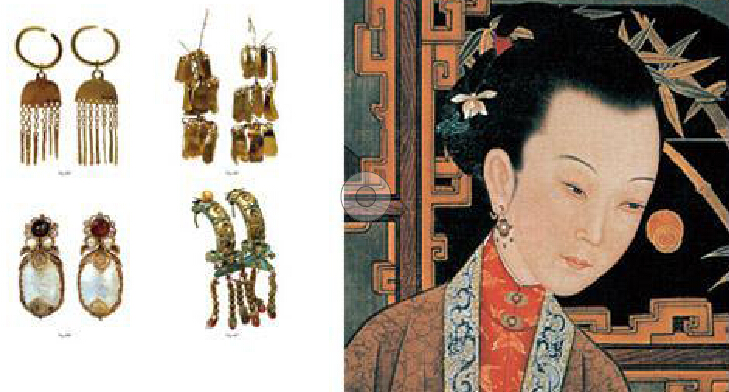Aesthetics in traditional Chinese clothing

Left: Fashion accessories popular in the Qing Dynasty(1644–1911). Right: One of the 12 beauties in Yongzheng Emperor (1678-1735) period of the Qing Dynasty.
Clothing forms an integral part of traditional Chinese civilization, reflecting social conditions and people’s spiritual pursuit at different times.
China’s clothing culture has produced distinctive aesthetic characteristics and tastes throughout different periods, which altogether form a unique system of clothing culture. In turn, aesthetics in traditional clothing influenced people’s psychology and preference in terms of dressing. The study of aesthetic thoughts embodied in China’s culture of traditional clothing is conducive to promoting the development of Chinese culture and its clothing industry.
As a cultural phenomenon, clothing culture is a symbol both of an era and of the amalgamation among nationalities. The style, color, materials and accessories used in Chinese traditional clothing have all manifested aesthetic thoughts and indicated people’s cultural standing, religious beliefs, mentality and aesthetic appreciation. Clothing has also reflected the social trends and development level of different time periods. Amid social development and economic growth, the aesthetic thoughts embodied in clothing have formed a distinct system.
Aesthetics for social norms
In traditional Chinese society, Confucian orthodoxy was the mainstream thought and subsequently had far-reaching influence on clothing. “To discipline yourself is to act according to the rites” and “When accomplishments and solid qualities are equally blended, we then have the man of virtue” were two Confucian ideas that influenced clothing. Confucianism stresses one’s ethics in their clothing, highlighting compliance with social rites and norms. The criterion of social ethics for judging the beauty of clothing laid the social foundation for aesthetics in traditional clothing.
Aesthetics for natural beauty
Taoism was an important school of philosophy in ancient China. Laozi, the founder of philosophical Taoism, famously said: “Man takes his law from the Earth; the Earth takes its law from Heaven; Heaven takes its law from the Tao. The law of the Tao is being what it is.”
That man is an integral part of nature is a basic idea in Chinese philosophy, and it is also the philosophical foundation for aesthetics in traditional Chinese clothing. Taoism holds that beauty is naturally reflected in the human body and clothing should be made to suit the human body. Taoism opposes excessive decorations on clothing and uses comfort as the major criterion to judge the beauty of clothing.
Aesthetics for harmony
One of the earliest Chinese works of narrative history, Zuo Zhuan (Chronicle of Zuo), proposes that seemingly opposing factors can actually exist in unity. For thousands of years, traditional Chinese clothing has observed the unity between cultural connotation and forms of representation, aesthetical convention and social functions. Traditional clothing also demonstrates the highest harmony and unity between clothing and nature, clothing and society, and clothing and people.
Aesthetics for forms
China is a vast country with many nationalities, who exhibit huge differences in styles, colors, materials and imagery in clothing. Moreover, every dynasty had its distinctive clothing designs and customs, bearing rich cultural connotations and unique aesthetic thoughts. All these varieties of region-distinctive or period-distinctive clothing with distinctive cultures enrich the annals of traditional Chinese clothing, providing abundant sources for the development of China’s clothing industry.
